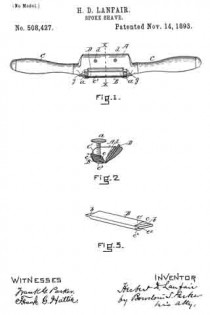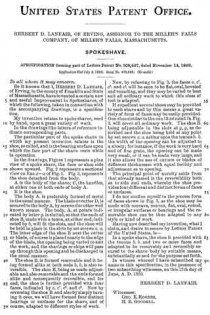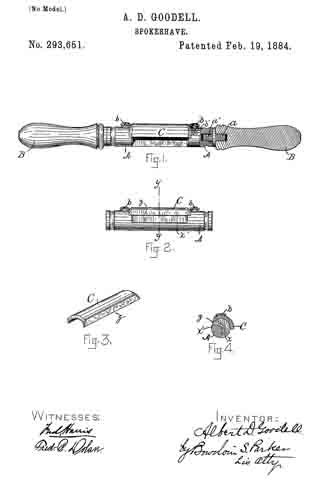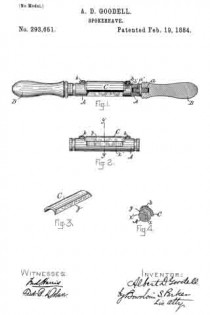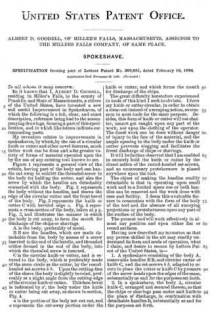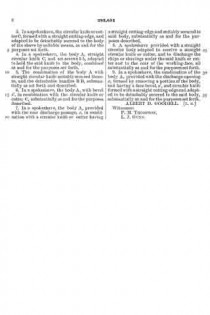No. 508,427 – Spokeshave (Herbert D. Lanfair) (1893)
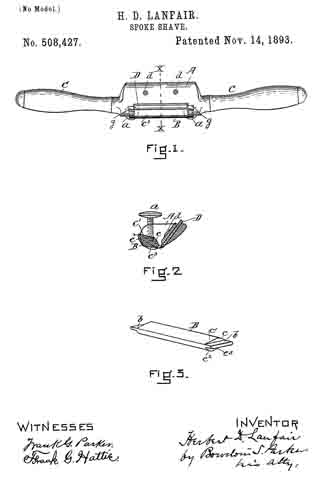
UNITED STATES PATENT OFFICE.
_________________
HERBERT D. LANFAIR, OF ERVING, ASSIGNOR TO THE
MILLER’S FALLS COMPANY, OF MILLER’S FALLS, MASSACHUSETTS.
SPOKESHAVE.
_________________
SPECIFICATION forming part of Letters Patent No. 508,427, dated November 14, 1893.
Application filed July 3, 1893. Serial No. 479,446. (No model.)
_________________
To all whom it may concern:
Be it known that I, HERBERT D. LANFAIR, of Erving, in the county of Franklin and State of Massachusetts, have invented a certain new and useful Improvement in Spokeshaves, of which the following, taken in connection with the accompanying drawings, is a specification.
My invention relates to spoke shaves, used by hand, upon a great variety of work.
In the drawings like letters of reference indicate corresponding parts.
The particular part of the spoke shave to which my present invention relates is the shoe, so called, and is the bearing surface upon which the face part of the shave rests while in operation.
In the drawings, Figure 1 represents a plan view of a spoke shave, the face or shoe side shown upward. Fig. 2 represents asectional view on line x–x of Fig. 1. Fig. 3, represents the shoe detached from the body.
A is the body of the shave; C, the handles, at either one or both ends of body A.
B is the shoe.
The body A. is preferably formed of metal in the usual manner. The blade or cutter D, is secured to the body A, by screws d or other well known means. The body, A, at points indicated by letter g, is slotted, so that the ends of shoe B, made with a tenon, at either end, indicated by b, will fit the slots, and the shoe will be held in place in the slots by set screws a a. The inner edge of the shoe B next the cutter or blade, of course is placed nearly to the edge of the blade, the opening being varied to suit the work, and the shavings or chips will pass up through this opening and be discharged in the usual manner.
The shoe B. is formed removable and it being formed alike at both ends b, b, is also reversible. The shoe B, being so made adjustable and also removable and the ends formed alike and consequently reversible, end for end, the shoe is further provided with four faces, indicated by c. c’. c2. and c3. New by reversing the shoe B. and also by simply turning it over, we will have formed four distinct bearings or surfaces for the shave, and of course, adapted to different styles of work.
Now, by referring to Fig. 3, the faces c. c’. c2. and c3. will be seen to be flat, oval, beveled and rounding, and they may be varied to best suit all ordinary work to which this class of tool is adapted.
If expedient several shoes may be provided to each shave and by this means a great variety of form of faces may be easily provided. One slice similar tothe one illustrated in Fig. 3. will cover all ordinary work. The shoe B. being adjustable in the slots at g, g, as described and the shoe being held at any point by set screws a. a. acting upon the tenons b. b. the width of the opening can be adjusted to a nicety; for instance, if the work is very hard and of fine grain, the opening can be made very small, or it can be made very large, and it also allows the use of cutters or blades of different thicknesses with equal facility and adjustment as to opening.
The principal point of novelty aside from that already named is the reversibility both as to side and ends, whereby the shoe provides four different and distinct forms of faces or surfaces.
I do not confine myself to the precise form of faces shown in Fig. 3, as the shoe may be made with concave, convex, flat, oval, round, or irregular surfaces or bearings and the removable shoe can be thus adapted to any A style or kind of work.
Having now described my invention, what I claim, and desire to secure by Letters Patent of the United States, is —
In a spoke shave, the shoe B. provided with the tenons b. b. and two or more faces and adapted to be removably and reversibly secured to the shave body by suitable means, I substantially as and for the purpose set forth.
In witness whereof I have subscribed my name to this specification, in the presence of two subscribing witnesses, on this 17th day of June, A. D. 1893.
HERBERT D. LANFAIR.
Witnesses:
GEO. E. ROGERS,
H. E. GOODELL.

